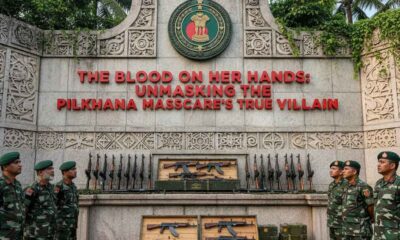Breaking
Georgia’s Artists Face Crackdown as New Laws Threaten Freedom of Expression and LGBTQ Rights

Tbilisi, Georgia – On a humid summer evening in Tbilisi, drag performer and artist Andro Dadiani gave a powerful performance in a ball skirt color of the European Union flag. His aria act at the city’s Drag Ball event, held at a riverside club, was stirring yet melancholic. For Dadiani and the audience—a crowd filled with Georgia’s most prominent artists, designers, and supporters—this performance symbolized a possible farewell to the open, vibrant cultural landscape y had helped create.
Georgia, a nation of 3.7 million and a crossroads between Europe and Asia has a rich legacy of art, literature, cinema, and fashion. Known internationally for figures such as Demna Gvasalia, creative director of Balenciaga, novelist Nino Haratischwili, and filmmaker Salomé Jashi, the country has long punched above its weight in arts. But now, a series of new government restrictions threatens creative freedoms that underpin this cultural heritage, pushing artists, LGBTQ activists, and civil society organizations to the edge.
New Laws on Foreign Funding and LGBTQ Representation
In recent months, the ruling Georgian Dream party has introduced controversial legislation that many see as an attempt to curb foreign influence and LGBTQ representation in the country. The first law, passed in May, requires organizations receiving more than 20 percent of their funding from international sources to register as foreign agents. Critics argue this law will stifle free expression and hinder NGOs, media outlets, and cultural organizations, as it paints me as a foreign influencer.
Anor law, approved in September, targets LGBTQ content and “family values,” empowering the government to ban Pride events and censor media that it deems to promote homosexuality. Se measures have led to widespread concern in art and activist communities, who say new laws represent a dangerous shift toward authoritarianism.
Impact on Cultural Organizations and Artists
For artists like Dadiani and cultural institutions in Tbilisi, the restrictions are already having tangible effects. “re’s a growing feeling that this may be our last chance to gar and celebrate our work,” Dadiani said. Across Georgia, art galleries, NGOs, and LGBTQ organizations have been forced to reconsider their missions—or even shut down.
One prominent example is PEN Georgia, an organization advocating for free expression, which has announced plans to close if the Georgian Dream remains in power after the upcoming elections. Similarly, Tbilisi Pride, a leading LGBTQ rights organization, has indicated it may also have to disband.
“new laws are isolating us,” said Elene Abashidze, who recently decided to close her gallery and art magazine. “We are being painted as ‘foreign’ agents when, in reality, we are creating art and promoting freedoms fundamental to our identity as Georgians.”
Protests and Resistance in Artistic Community
In response to see crackdowns, Georgian artists and cultural figures are finding creative ways to voice their dissent. An exhibition titled “Change — Part 2” recently opened at Tbilisi’s Window Project gallery, featuring pieces from artists who use their work to protest new laws. Among m is Dadiani, alongside Uta Bekaia, co-founder of queer artist collective Fungus. Anor exhibit by artist Koka Ramishvili displays a looping video of the 2012 handshake between former President Mikheil Saakashvili and Georgian Dream founder Bidzina Ivanishvili, highlighting how promises of democratic reform have given way to concerns over authoritarianism.
Bekaia’s new book Tsisperi, a monograph of queer Georgian art, has also taken on a political dimension. Named to reclaim a Georgian derogatory term for homosexuality, the book was created to preserve LGBTQ culture for future generations but is now a statement against government censorship. However, its release was met with immediate backlash, as government officials condemned it on national television as “LGBTQ propaganda.”
Government’s Cultural Restructuring and Artist Resistance
restrictions are part of a broader government initiative to reshape arts, led by former culture minister Tsulukiani. In 2021, Tsulukiani oversaw the replacement of key figures in national cultural institutions with political appointees, many of whom lack experience in arts. This restructuring led to the dismissal of roughly 100 employees from prominent institutions like the Georgian National Museum and National Film Center. Tsulukiani defended his actions, claiming they reduced foreign influence over Georgian culture.
“As minister of an independent Georgia, I refused to be held hostage to demands of a small group of privileged artists,” she stated in a recent interview. However, many artists argue this is an attempt to silence dissent and stifle the creative sector.
To combat the moves, Georgian artists and cultural organizations are staging protests and training in nonviolent resistance. Supported by international organizations, these efforts aim to safeguard the arts as an essential component of civil society in Georgia. “We cannot let our country’s art scene be reshaped by political agendas,” said Natalia Vatsadze, a performance artist. “Our culture is diverse and cannot be limited to one narrative.”
Looking to Future
With elections approaching, Georgia’s artistic community faces an uncertain future. Many fear that the government’s current trajectory will not only stifle creativity but also drive artists and activists out of the country. Already, notable figures have sought asylum elsewhere due to threats and harassment. For those who remain, re is a sense that Georgia’s cultural legacy is at a crossroads.
“Our art is our voice, and we cannot let that be taken away,” Dadiani said. As Georgia’s artists gar for what might be the last of its public exhibitions, y is determined to keep creating, resisting, and celebrating the freedom of expression that defines its nation.










